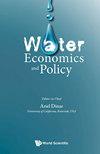Joint-Financing Framework for Water Services in the Thousand Island Lake Water Distribution Project in Eastern China
IF 1.3
4区 经济学
Q3 ECONOMICS
引用次数: 0
Abstract
Valuing water is difficult and contentious owing to water’s physical, political, and economic characteristics. Combining household-level and county-level data at the county level could clarify the responsibilities of both the government and users. In the Thousand Island Lake Water Distribution Project (TILWDP), the upstream ecosystem services provider, Chunan County, is assumed to sustain a tremendous opportunity cost due to the extremely strict environmental protection requirements of the project. To estimate the opportunity cost of supplying fresh water that meets the standards of the National Primary Drinking Water Regulations, a synthetic control model is introduced, and county-level macroeconomic data are used. A funding gap was estimated in the current government-financed situation. Meanwhile, willingness to pay is calculated based on household-level data collected in the downstream area. The estimate indicates that the combination of ecological compensation payments from governments and downstream stakeholders’ willingness to pay for water services could completely cover the upstream service provider’s opportunity cost. Specifically, the related central and downstream governments would need to take on approximately 1/3 of the total cost, while the users from the downstream area would take on the rest. The proposed policies include adopting government–user joint-financing payment for ecosystem services (PES) schemes for regional ecological and environmental cooperation in China, implementing diversified payment vehicles, launching additional environmental education projects, etc.中国东部千岛湖配水工程供水服务联合融资框架
由于水的物理、政治和经济特征,对水的估价既困难又有争议。将县级的家庭和县级数据结合起来,可以明确政府和用户的责任。在千岛湖配水项目(TILWDP)中,由于该项目极其严格的环境保护要求,上游生态系统服务提供商淳安县被认为将承受巨大的机会成本。为了估算供应符合《国家一级饮用水条例》标准的淡水的机会成本,引入了一个综合控制模型,并使用了县级宏观经济数据。在目前政府资助的情况下,估计存在资金缺口。同时,支付意愿是根据下游地区收集的家庭水平数据计算的。估计表明,政府支付的生态补偿金和下游利益相关者支付供水服务的意愿相结合,可以完全覆盖上游服务提供商的机会成本。具体而言,相关的中央和下游政府将需要承担约1/3的总成本,而下游地区的用户将承担其余成本。拟议的政策包括在中国区域生态环境合作中采用政府-用户联合生态系统服务融资支付(PES)方案,实施多样化的支付工具,开展额外的环境教育项目等。
本文章由计算机程序翻译,如有差异,请以英文原文为准。
求助全文
约1分钟内获得全文
求助全文

 求助内容:
求助内容: 应助结果提醒方式:
应助结果提醒方式:


